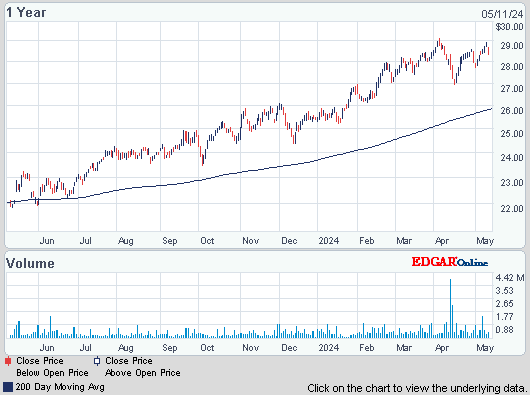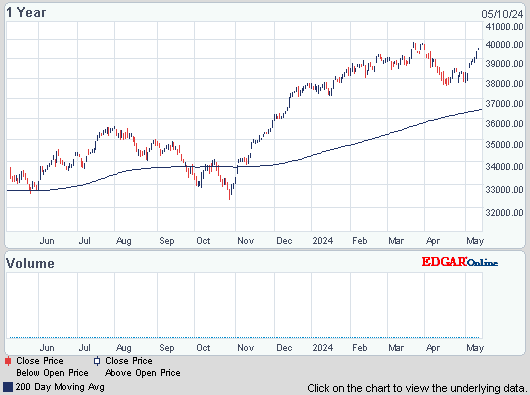Dow crawled up 16, advancers ahead of decliners 3-2 & NAZ rose 26. The MLP index was off a fraction in the 441s & the REIT index rose fractionally in the 262s (still down more than 50 from its yearly high). Junk bond funds were little changed as were Treasuries. Oil fell on easing tensions from the MidEast. Gold retreated the most in more than 2 weeks as better-than-expected US economic data reinforced
the case for the Federal Reserve (FED) to slow stimulus measures.
AMJ (Alerian MLP Index tracking fund)

![Live 24 hours gold chart [Kitco Inc.]](http://www.kitco.com/images/live/gold.gif)

Federal Reserve Bank of Richmond President Jeffrey Lacker said the future of global central banks will be shaped partly by a debate over the extent of their role as a lender of last resort. Lacker said central banks should avoid channeling credit to specific segments of the economy thru rescues or asset-purchase programs. Still, “some writers” say central bank mandates provide a large role in financial stability, “in which all available tools, both monetary and credit policy, are used to minimize financial system ‘disruptions,’” he said. “Aggressive use of a central bank’s asset portfolio to channel credit to particular economic sectors or entities threatens dragging the central bank into distributional politics and places that governance arrangement at risk,” Lacker said. Lacker dissented on FOMC decisions at all 8 meetings last year & doesn’t vote again until 2015. Credit policies are distinct from monetary policy in that they channel cash to specific segments of the economy. The FED’s purchase of the assets of Bear Stearns to facilitate its merger with JPMorgan Chase (JPM), in 2008 is one example, & its recent quantitative easing programs involving the purchase of mortgage-backed securities is another, Lacker said. “Buying agency MBS channels funds to mortgage borrowers,” Lacker said in prepared remarks. Big Ben & his colleagues orchestrated the most aggressive easing in FED's 100-year history to help secure the FED’s explicit mandate to achieve stable prices & full employment.
Fed’s Lacker Says Central Banks’ Future Hinges on Role as Lender
The global oil market is adequately supplied & doesn’t require the release of emergency stockpiles, according to the International Energy Agency (IEA). The agency is monitoring the market & “stands ready” to respond if there’s a major supply disruption, the adviser to 28 energy-consuming nations said. The IEA coordinated the release of 60M barrels of crude & oil products in Jun 2011 to offset lost supplies from Libya, where an uprising against Muammar Qaddafi almost halted the country’s oil exports. Brent fell 8% in the 2 days after the announcement of that intervention, the 3rd use of reserves in the agency’s history. Brent has climbed 12% in 3 months amid unrest in Egypt, declining supply from Libya & the escalating conflict in Syria. Libya’s oil production fell to 1/8 of its capacity as protests over pay & allegations of corruption spread. Output from the North African OPEC nation slumped to about 200K barrels a day, compared with 640K in Aug & its optimal capacity of 1.6M, National Oil Chairman Nuri Berruien said from Tripoli.
Global Crude Oil Market Is Adequately Supplied, IEA Says
US banks earn record $42.2B in 2nd quarter Associated Press
Another quiet day when not much was done in the last week of Aug. The economic data today was favorable, the officials at the FED are also reading it. QE3 will be on its way out & that should be announced in a few weeks. As low as volume was today, it will be lower tomorrow. Bombing Syria is an iffy thing with fuzzy objectives. Over a long holiday weekend in the US, chances are nothing will be done.
Dow Jones Industrials

AMJ (Alerian MLP Index tracking fund)
Treasury yields:
U.S. 3-month |
0.02% | |
U.S. 2-year |
0.39% | |
U.S. 10-year |
2.75% |
| CLV13.NYM | ...Crude Oil Oct 13 | ....108.82 | (1.2%) |
![Live 24 hours gold chart [Kitco Inc.]](http://www.kitco.com/images/live/gold.gif)

Federal Reserve Bank of Richmond President Jeffrey Lacker said the future of global central banks will be shaped partly by a debate over the extent of their role as a lender of last resort. Lacker said central banks should avoid channeling credit to specific segments of the economy thru rescues or asset-purchase programs. Still, “some writers” say central bank mandates provide a large role in financial stability, “in which all available tools, both monetary and credit policy, are used to minimize financial system ‘disruptions,’” he said. “Aggressive use of a central bank’s asset portfolio to channel credit to particular economic sectors or entities threatens dragging the central bank into distributional politics and places that governance arrangement at risk,” Lacker said. Lacker dissented on FOMC decisions at all 8 meetings last year & doesn’t vote again until 2015. Credit policies are distinct from monetary policy in that they channel cash to specific segments of the economy. The FED’s purchase of the assets of Bear Stearns to facilitate its merger with JPMorgan Chase (JPM), in 2008 is one example, & its recent quantitative easing programs involving the purchase of mortgage-backed securities is another, Lacker said. “Buying agency MBS channels funds to mortgage borrowers,” Lacker said in prepared remarks. Big Ben & his colleagues orchestrated the most aggressive easing in FED's 100-year history to help secure the FED’s explicit mandate to achieve stable prices & full employment.
Fed’s Lacker Says Central Banks’ Future Hinges on Role as Lender
The global oil market is adequately supplied & doesn’t require the release of emergency stockpiles, according to the International Energy Agency (IEA). The agency is monitoring the market & “stands ready” to respond if there’s a major supply disruption, the adviser to 28 energy-consuming nations said. The IEA coordinated the release of 60M barrels of crude & oil products in Jun 2011 to offset lost supplies from Libya, where an uprising against Muammar Qaddafi almost halted the country’s oil exports. Brent fell 8% in the 2 days after the announcement of that intervention, the 3rd use of reserves in the agency’s history. Brent has climbed 12% in 3 months amid unrest in Egypt, declining supply from Libya & the escalating conflict in Syria. Libya’s oil production fell to 1/8 of its capacity as protests over pay & allegations of corruption spread. Output from the North African OPEC nation slumped to about 200K barrels a day, compared with 640K in Aug & its optimal capacity of 1.6M, National Oil Chairman Nuri Berruien said from Tripoli.
Global Crude Oil Market Is Adequately Supplied, IEA Says
Banks in the US earned more in Q2 than during any
qtr on record, aided by a steep drop in losses from bad loans. The Federal Deposit Insurance Corp (FDIC) says the banking industry earned
$42.2B, up 23% from Q2 last year. About 54% of banks reported improved
earnings from a year earlier. Banks' losses on loans tumbled 30.7% from a year earlier to
$14.2B, the lowest in 6 years. But bank lending increased 1% from Q1. Greater lending helps boost consumer &
business spending, leading to more jobs and faster economic growth. Still, the report shows that the largest banks continue to drive the
industry's profits while smaller institutions have struggled. Banks with
assets exceeding $10B make up only 1.5% of US banks.
Yet they accounted for 82% of the industry's earnings. One concern is the recent spike in interest rates. Rates have risen
since May. But bond purchases by the FED have kept long-term
interest rates low. Another sign of the industry's health is that fewer banks are at risk
of failure. The number of banks on the FDIC's "problem" list fell to
553 as of Jun 30 from 612 in 3 months earlier. So far this year, only 20
banks failed, following 51 closures last year, 92 in 2011 &
157 in 2010. The 2010 closures were the most in one year since the
height of the savings & loan crisis in 1992.
Another quiet day when not much was done in the last week of Aug. The economic data today was favorable, the officials at the FED are also reading it. QE3 will be on its way out & that should be announced in a few weeks. As low as volume was today, it will be lower tomorrow. Bombing Syria is an iffy thing with fuzzy objectives. Over a long holiday weekend in the US, chances are nothing will be done.
Dow Jones Industrials
Like many of you, I’m a huge fan of INO, and from what I have seen so far, their service Marketclub! This isn’t a stripped down version, everything in MarketClub is available to you. I don’t want to give everything away, but you’ll have unlimited access to my favorite three tools: Trade Triangles, Smart Scan, and Alerts! The best part is that the MarketClub customer support team will be providing UNLIMITED support! You can call or email for an instant response to any question, comment or concern.
Here’s that link:
https://club.ino.com/join/specialtrial/index_free.html?a_aid=CD3289&a_bid=359ef9a3
I’ll get you more info a little bit later, but I’d recommend you jump on this now.








No comments:
Post a Comment